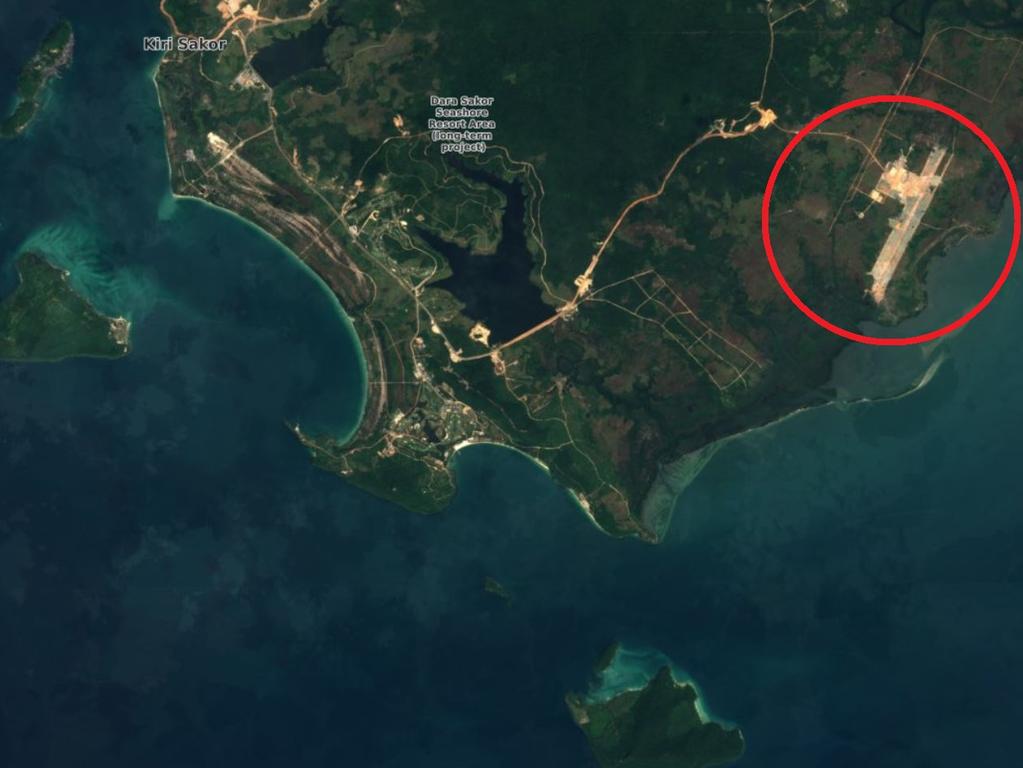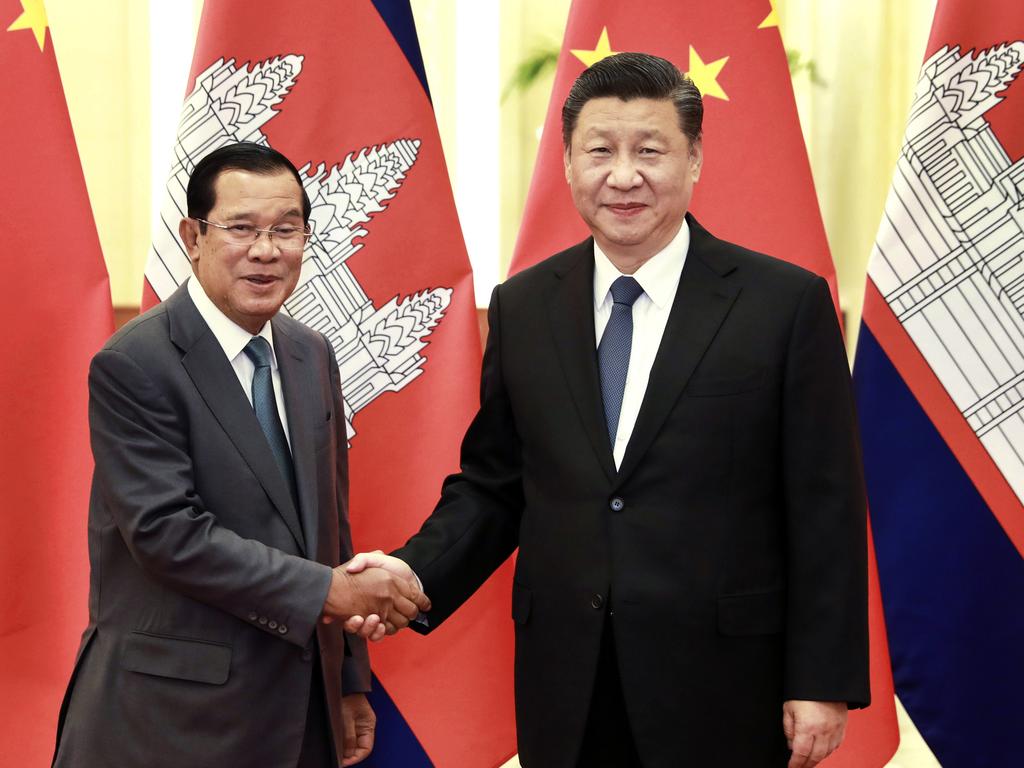Scary reality: China’s secret Cambodian military base
It’s supposed to be an international airport. It’s supposed to be part of a holiday resort on a pristine piece of coastline. But it’s not.
It’s supposed to be an international airport. It’s supposed to be part of a large-scale holiday resort on a pristine piece of Cambodian coastline. But it’s not.
Some 45,000 hectares of an unspoilt national park is being ripped up to build it. Deep-water channels are being dredged through the clear waters.
Little wonder the Koh Kong Beachside Resort has failed to attract visitors to its casino and hotel facilities.
Work on the $US3.8 billion tourism development appears to have stalled, which is why military analysts have been pouring over satellite photographs tracking the enormous airfield’s continued construction.
They’ve noted a few peculiar points.

Many of the aircraft turning bays are too small for large commercial airliners. Instead, they’re just right for fighter jets. And exactly why it needs to be 3400m long is uncertain.
That’s far larger than even the largest civilian airliners require to land or take off. There is no significant nearby population or industrial centre. And its enormous scale goes far beyond the needs of the languishing Koh Kong resort nearby.
It wouldn’t be the first time Beijing has engaged in major military infrastructure projects under the guise of building a casino.
Its first aircraft carrier, the ex-soviet Riga, was bought from Ukraine in 1998 under the pretence of being turned into a floating betting facility and hotel. In 2012, it emerged as the fully armed and operational combat ship – the Liaoning.
Indications are it is a similar story at Dara Sakor.
CONFLICT ZONE
Chinese naval and coastguard vessels continue to ply the northern waters of Indonesia’s Exclusive Economic Zone (EEZ). There’s nothing illegal about that, but their presence is a deliberate reminder that Beijing ordered its fishing fleet into the area earlier this year.
That provoked a military standoff with Jakarta.
Late January, Beijing finally backed down.
Next time, however, may be different. Especially if the Chinese fishing fleet is watched over by strike aircraft and naval vessels staging out of nearby Cambodia.
While Beijing claims the entirety of the South China Sea, it only borders the northernmost edge. China’s controversial artificial island fortresses have secured its presence in the sea’s middle regions. But it has nothing imposing control over the extreme south, which is likely why the enormous muddy scar is being gouged out of Cambodia’s forest landscape.
An air and naval base at Dara Sakor would give the People’s Liberation Army Air Force (PLAAF) and navy (PLAN) easy access to waters contested by Vietnam, Malaysia and Indonesia. And the strategically vital narrow shipping lane of Malacca Strait.
“This will allow China to project its air power through the region, and it changes the whole game,” political scientist Sophal Ear told the New York Times.
HOUSE RULES
The Chinese state-controlled Union Development Group is behind what it declares will become a large, self-sustaining holiday city in Cambodia’s Koh Kong province.
Its promotional spiel envisages “a nearly complete economy, with medical treatment centres, condominiums, resorts and hotels, manufacturing facilities, a deepwater port, and an international airport.”
It just happens to be the longest runway in Cambodia. And the planned port just happens to meet the needs of China’s largest destroyers.
This plan for a supposed self-sustaining tourist city caught the eye of the Washington-based Centre for Advanced Defense Studies (C4ADS).
“The Pilot Zone’s planned hospitals and recreational areas could theoretically host People’s Liberation Army Navy crews on patrol in the Gulf of Thailand and on the eastern side of the Malacca Strait,” the C4ADS Harbored Ambitions report reads.
“Its proposed future industrial capacity could also theoretically provide logistic support to Chinese warships in line with strategies proposed by China’s analysts.”
The deal – under Beijing’s Belt and Road Initiative international infrastructure investment program – appears particularly dodgy. Union Development Group has secured exclusive access to almost a quarter of Cambodia’s coastline for 99 years. According to This Week In Asia, it is getting the lot for just $US1 million each year in rent.
This is despite such a deal being against Cambodian law.
But wait, there’s more.
China recently sealed an exclusive deal to rebuild and expand Cambodia’s main Ream naval base at Sihanoukville. According to the Wall Street Journal, Beijing and Phnom Penh signed the secret agreement last year. It will allow China’s navy access for the next 30 years.
DIPLOMATIC GAMBLE
Cambodia’s authoritarian leader, Hun Sen, has turned a blind eye to the project’s legal impediments. He’s spent his 34 years in power undermining the rule of law and free elections. He’s recently been sanctioned by the US over corruption claims.
Hun Sen’s government denies any military deal with China. President Xi Jinping’s government denies any military deal with Cambodia.
Analysts aren’t so sure.
“The PRC appears to be employing Belt and Road Initiative (BRI) funding to further strategic co-operation with Cambodia through the construction of potential dual-use infrastructure,” a Jamestown Foundation report reads.
“Ream naval base is the latest in a network of regional security projects — including Cambodia’s Dara Sakor investment zone and Thailand’s Kra Canal — which, taken together, significantly improve Chinese power projection into the Indian Ocean Region.”
At present, China has just one overseas military base. It built a port in Djibouti, on the Horn of Africa, under the premise of it being a UN facility to combat piracy in the region.
But it’s also engaged in military-grade construction work on Sri Lanka’s Hambantota and Pakistan’s Gwadar ports.

HIGH STAKES GAME
The United States has been digging in its heels over China’s militarisation of the South China Sea. It has stepped up its “freedom of navigation” patrols, aimed at demonstrating its right to send warships through international waters. It also last year called on Beijing to remove the missiles it had installed on its controversial island fortresses.
But analysts have noted a Chinese presence in Cambodia would tip the balance of power considerably. It would give Beijing the military reach in southern South East Asia it currently lacks.
“News of the Ream agreement raises the spectre of increasing Chinese maritime militarisation at a time of intense unease in Southeast Asia,” The Jamestown Foundation states.
Dara Sakor is in Cambodia’s southwest, near the Thai border. It overlooks the Gulf of Thailand.
Chinese military facilities there would give Beijing complete dominance over another major Belt and Road infrastructure project: a canal cut across Thailand’s narrow Isthmus of Kra to link the South China Sea and the Indian Ocean.
This would enable Chinese military and commercial shipping to bypass the narrow Malacca Strait, through which most of its energy imports pass.
A Chinese military presence at Dara Sakor would outflank Vietnam, forcing Hanoi to divert forces from its northern border to the west. But the airfield would also position Beijing’s forces within easy reach of Indonesia’s Natuna islands – and put its strategic bombers within range of India’s southernmost military facilities.
Jamie Seidel is a freelance journalist specialising in international affairs. Continue the conversation @JamieSeidel



